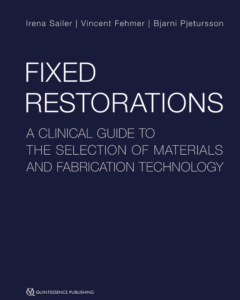It’s no secret that technology is changing the way the world operates, and the field of fixed prosthodontics is no exception. With recent advances in CAD/CAM, 3D printing, and improvement in material properties, it can be difficult to stay up to date and informed on which treatment protocols are best. That’s why, when asked to write a foreword for Fixed Restorations: A Clinical Guide to the Selection of Materials and Fabrication Technology, Prof Dr Markus Hürzeler reconsidered his initial reaction—Do we need a book about fixed prosthodontics in this day and age?—because the answer is a resounding yes.
“It seems essential for the dental community to have an overview and guidelines of the current state of the art . . . considering the last decades of dentistry, it is apparent that a clinician will never be in the position of always being up to date in the fields of new materials and new manufacturing techniques of fixed restorations,” he summarizes. Additionally, while mechanistic therapeutic concepts and aspects of materials science have largely informed decision-making in restorative dentistry, these concepts have been challenged in recent years and replaced by ones that are biologically oriented. Periodontal, endodontic, and prosthetic approaches are all necessary for successful treatment outcomes with fixed prosthodontics. And, with the constant and rapid changes in technologies, laboratory technical expertise and familiarity with dental materials are also necessary.
Considering the different components needed to ensure successful prosthetic treatment, there was no better team to bring this book to life than Drs Irena Sailer, Vincent Fehmer, and Bjarni Pjetursson, who have united the fields of restorative dentistry, periodontology, and technical expertise. Staying up to date is much more manageable thanks to the trio’s efforts to collect the current evidence and best practices for material selection in fixed restorations. After all, “material selection” covers only part of the decision-making process—patient needs and fabrication technology are just as important as material properties when making these decisions.

Flowchart of material selection for tooth-supported single-unit restorations (minimally invasive, defect-oriented, and conventional).
Advances in technology mean that, in restorative dentistry, “the wax and modeling are evolving into software and mouse-clicks.” It’s true that technology has increased manufacturing efficiency, accuracy, and speed, but it has also allowed for improved patient communication. For instance, 3D-printed preparation guides or virtual mock-ups have proven to be useful tools for patient consultation as well as for the fabrication process. Likewise, augmented reality and facial recognition applications already exist for patient communication purposes, but show potential for use in fabrication technologies.
It might seem oxymoronic to compare one fabrication technology that could be used for communication to a communication technology that could be used for fabrication, but this sort of interplay couldn’t be more important for fixed prosthodontic treatment. After all, even when choosing a material, it is necessary to consider how a variety of clinical factors affect one another—do the quality and quantity of the remaining tooth substance allow for a conservative treatment like adhesive cementation, or are there factors at play that will require more preparation while remaining minimally invasive? Will any sacrifices, such as increasing the amount of preparation and material thickness to compensate for translucency, need to be made to ensure optimal esthetics? A single-tooth restoration is going to require different considerations than a multiple-unit restoration, so what kind of material and fabrication properties need to inform that treatment choice?

Translucency of different materials. From left to right; the leucite-reinforced glass-ceramic, feldspathic ceramic, zirconia, In-Ceram alumina, and In-Ceram zirconia samples have the same thickness (0.5 mm), and show obvious differences in translucency.
In addition to the sorts of questions a practitioner may pose to themselves, practitioners must also be ready to answer the patient’s questions, especially since it is so common for patients to research treatments themselves online before consulting a practitioner. It is important to respond to these informed questions and to correct any misconceptions if the patient’s information source is less than reliable, making it even more imperative to stay up to date with the current evidence, best treatment practices, and interplay of treatment considerations.
Many factors come together to ensure excellent fixed prosthesis treatment, and a whole book, split into four parts, was necessary to cover all of them. Fixed Restorations: A Clinical Guide to the Selection of Materials and Fabrication Technology was brought to life not only by the professional drive and expertise of its three authors, but also by their friendship, collaboration, and chemistry—ideals that can also be seen in good fixed prosthodontic treatment.
 Fixed Restorations: A Clinical Guide to the Selection of Materials and Fabrication Technology
Fixed Restorations: A Clinical Guide to the Selection of Materials and Fabrication Technology
Irena Sailer, Vincent Fehmer, and Bjarni Pjetursson
In this timely and comprehensive guide to modern reconstructive dentistry, the authors showcase their expert knowledge of materials combined with innovative digital smile reconstruction technology to produce stunning results. The book is divided into four parts: basic information regarding materials and production processes, step-by-step clinical procedures with extensive case presentations, long-term outcomes, and management of complications. With over 2,000 clinical images and diagrams, backed up with the scientific evidence for recommendations, the best practice for tooth- and implant-supported fixed restorations is clearly described. Cases are presented in all different types of restorations, from minimally invasive veneers to implant-supported full-arch prostheses and everything in between. The vast clinical and technical knowledge and experience of the authors has resulted in a unique textbook that will aid in decision making regarding material selection and procedures for all patients in need of fixed restorations.
752 pp; 2,750 illus; ©2021; ISBN 978-1-78698-027-4 (B0274); US $360
